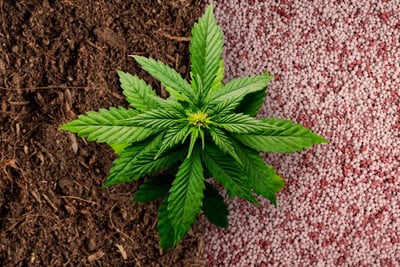 Weed Grow Guide by Royal Queen Seeds
Weed Grow Guide by Royal Queen Seeds
- Growing weed step by step
- Cannabis growing basics
- Choosing your seeds
- How to germinate seeds
- The cannabis vegetative stage
- The cannabis flowering stage
- Harvesting cannabis
- Trimming, drying, and curing
- Choosing pots and soil
-
Growing indoors
- A Complete Overview Of Growing Cannabis Indoors
- Cannabis Cultivation Tips: How To Set Up Indoor Grow Lights
- How Many Cannabis Plants Can You Grow Per Square Metre?
- Indoor Cannabis Growing: Relative Humidity and Temperatures
- Hydroponics Cannabis Growing Guide (with diagrams)
- Cannabis Micro Growing: Growing Great Weed in Tiny Spaces
- Growing outdoors
- How to grow autoflowering cannabis
- Cannabis nutrients and pH
- Cannabis troubleshooting: Nutrients
-
Cannabis troubleshooting: Growing
- Cannabis Seed Germination — Troubleshooting Guide
- How to Deal With Pythium (Root Rot) in Cannabis Plants
- Slow Cannabis Plant Growth And What You Can Do About It
- How to Prevent and Fix Stretching in Cannabis Seedlings
- Watering Your Cannabis: How to Fix Overwatering and Underwatering
- Understanding Male, Female, And Hermaphrodite Cannabis
- Identifying and Treating Common Cannabis Ailments
- How To Revive a Sick Cannabis Plant
- How to Avoid Mouldy Weed During Drying and Curing
- How to Prevent and Treat Dry and Crispy Cannabis Leaves
- What Cannabis Leaves Can Tell You
- Causes and Solutions for Yellow Cannabis Leaves
-
Cannabis Strains Grow Report
- HulkBerry Automatic Grow Report
- Blue Cheese Auto Grow Report
- Purple Punch Automatic Grow Report
- Triple G Automatic Grow Report
- Do-Si-Dos Automatic Grow Report
- Green Gelato Automatic Grow Report
- Haze Berry Automatic Grow Report
- Purple Queen Automatic Grow Report
- Cookies Gelato Automatic Grow Report
- Sherbet Queen Automatic Grow Report
- Sweet Skunk Automatic Grow Report
- Medusa F1 Grow Report
- Cannabis plant training
-
Weed growing tips
- The Cannabis Plant Anatomy
- How to preserve seeds
- How Much Sunlight Do Outdoor Cannabis Plants Need To Grow?
- How to Control and Prevent Stretching in Cannabis Plants
- My Cannabis Plants Are Growing Too Tall: What Should I Do?
- Should You Worry About Purple Or Red Cannabis Stems?
- What To Do When Your Indoor Cannabis Won’t Flower
- How To Protect Your Cannabis Plants From Heat Stress
- How To Tell If Your Female Cannabis Plant Has Been Pollinated
- Growing Medical Marijuana
- Bud Washing: How to Clean Your Weed
- Understanding Cannabis Yield per Plant

How to Prevent and Treat Nutrient Lockout in Cannabis
During your development as a cannabis grower, you’ll encounter a host of different challenges. As well as diseases and pests, you’ll likely run into nutrient lockout at some point. The symptoms of nute lockout are alarming, but you don’t need to worry too much. Below, you’ll learn how to fix this problem when it occurs, and how to prevent it going forward.
Contents:
- What is nutrient lockout and why does it happen?
- Signs of nutrient lockout in cannabis
- How to treat nutrient lockout in cannabis
- How to fix nutrient lockout in soil
- How to fix nutrient lockout in coco
- How to prevent nutrient lockout in cannabis
- Nutrient lockout: will cannabis plants recover?
- Nutrient lockout: you're prepared for this common problem
What Is Nutrient Lockout and Why Does It Happen?
Nutrient lockout might be due to the oversaturation of mineral fertilisers with high salt content. Cannabis nutrient lockout occurs when plants are unable to absorb the nutrients they need to survive, develop, and grow. Even when the growing medium contains all of the necessary nutrients, plants still show signs of deficiency because they’re unable to uptake them.
Essentially, your plants are starving although they’re surrounded by food. The pH of the growing medium has a large influence on a plant’s access to nutrients. These two letters stand for “potential of hydrogen” and are a unit of measure for the acidity or alkalinity of a growing medium. The pH scale ranges from 0–14, with 0–6 indicating acidity, 7 indicating neutral, and 8–14 indicating alkalinity.
Cannabis thrives at a pH of 5.5–6.5 in hydroponic systems and 6.0–6.8 in soil systems. Keep your pH in this range, and your plants will have access to all of the nutrients they need. If it gets too high or too low, you can experience cannabis lockout.
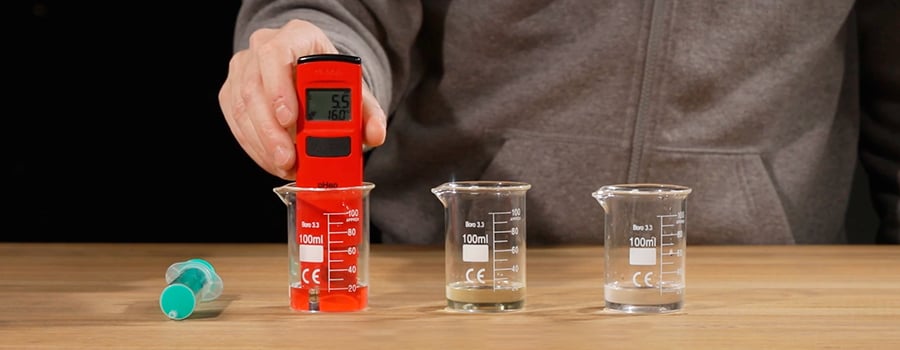
Nutrient Lockout or Deficiency?
Nutrient lockout and nutrient deficiencies share almost identical symptoms. This makes sense, considering that both conditions arise due to a lack of minerals in plant tissue. However, the root cause is slightly different.
Nutrient lockout occurs even in the presence of adequate levels of nutrients—plants simply can’t access them. In contrast, deficiencies can occur within an ideal pH range if nutrient levels are inadequate.
Signs of Nutrient Lockout in Cannabis
As a grower, you’ll become better equipped to deal with your cultivation problems if you know how to identify them. Below, you’ll learn how to pinpoint the signs of nute lockout.
Stunted Growth
Cannabis plants require several key nutrients to survive and grow. Macronutrients such as nitrogen play particularly important roles in plant growth. Nitrogen helps to make up the chlorophyll molecule that plants need to capture sunlight, and it contributes to amino acid molecules that plants need for structural development. When key minerals are locked out of plants, they become stunted and fail to thrive.
Yellowing Leaves
Yellow leaves, a condition known as chlorosis, are a major symptom of nutrient lockout. You’ll notice the lower leaves turn first, as this colour shift works its way upwards. As you’ve just learned, nitrogen plays a key role in chlorophyll molecules. Without adequate levels, plants won’t have what they need to craft this green pigment.
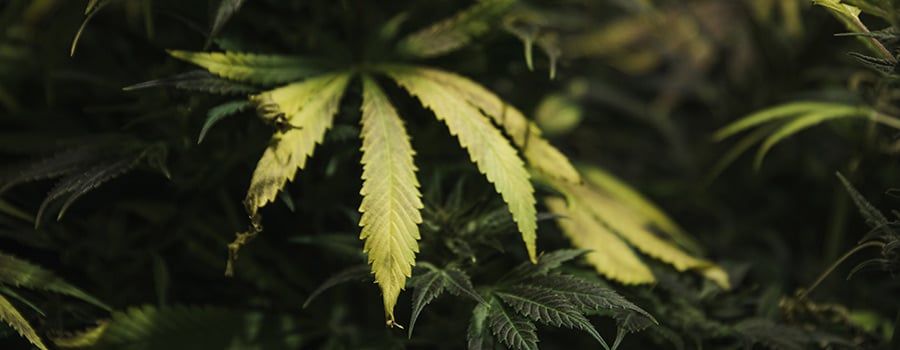
Leaf Discolouration
Plants don’t just turn yellow in the face of cannabis nutrient lockout; a range of different discolouration patterns can occur. For example, you might also notice shades of brown, purple, and red start to emerge.
Leaf Curling
Many nutrients are important for leaf health. In particular, nitrogen promotes luscious leaf growth, and phosphorus helps these structures to capture, store, and convert sunlight. A lack of minerals caused by nutrient lockout can cause leaves to curl either upwards or downwards.
Burnt Leaf Tips
Burnt leaf tips are another cosmetic sign that your weed plants are undergoing nutrient lockout. This alarming phenomenon occurs chiefly due to a lack of nitrogen making its way into leaf tissue.
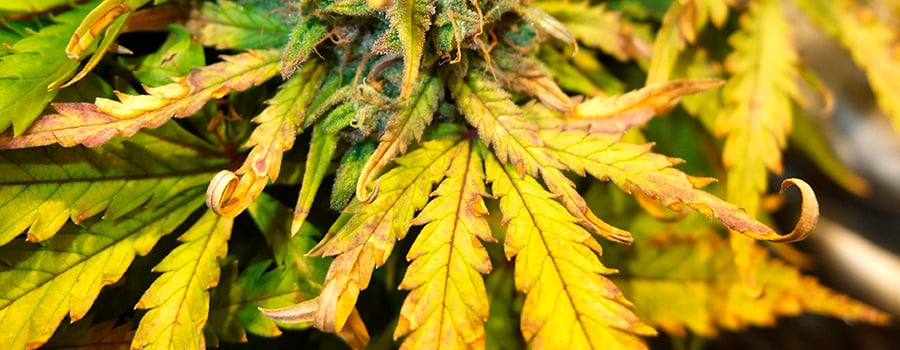
pH Imbalance
The symptoms mentioned above overlap with nutrient deficiency. To differentiate between both conditions, you’ll need to test the pH of your soil (more on that below). Lower pH ranges interrupt the uptake[1] of macronutrients and secondary nutrients, such as calcium and magnesium. When pH becomes too high, however, plants have a hard time accessing micronutrients.
How to Treat Nutrient Lockout in Cannabis
So, you’re now aware of the signs of cannabis nutrient lockout. Next, you’re going to learn the steps you should take if you see these symptoms crop up. These strategies include adjusting pH, flushing the growing medium, and applying foliar feeds. Learn more about these techniques, and others, below.
Adjust pH Levels
As you’re now aware, incorrect pH levels underpin nute lockout. If you test the pH of your substrate and it’s outside of the ideal range, you need to bring it back. There are several ways to go about doing this. A large range of pH “up” and “down” products are available for purchase.
If you prefer making your own inputs, then you can use lemon and vinegar to decrease pH, and baking soda to raise it. Make sure to only apply these substances in small quantities; go low and slow. Test after each application and continue to administer as needed.
Flush the Growing Medium
Synthetic fertilisers work well when it comes to rapidly remedying nutrient deficiencies. However, these ionic salts can build up in the soil over time and cause pH fluctuations, resulting in nutrient lockout.
Thankfully, they’re water-soluble. Withholding nutrients and flushing the growing medium with pH-balanced water can help to remove salt buildup and restore optimal pH in the growing medium. Flush your soil for several days before you start testing for pH. Resume normal feeding after results show a pH of 5.5–6.5 in hydro or coco, and 6.0–6.8 in soil.
Use Chelated Nutrients
Chelated fertilisers offer impressive advantages compared to standard mineral salts. They’re designed in a way that makes them more readily available to plants, and they’re more resistant to nutrient lockout, thereby helping to prevent the chances of subsequent deficiencies.
Apply Foliar Feeds
Foliar feeding refers to spraying nutrient solution directly onto the leaves of plants. Cannabis leaves possess many tiny holes, called stomata, that allow for gas exchange. Ionic nutrients can also gain entrance through the stomata, and in doing so bypass the root network. While fixing issues with the soil, consider applying foliar feeds to reduce the impact of potential deficiencies.
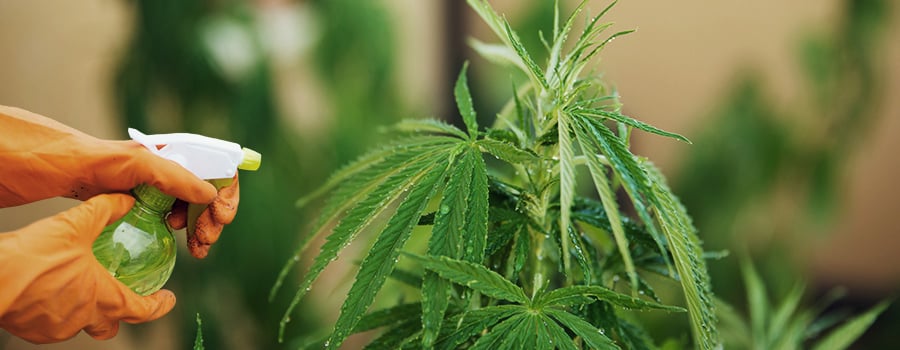
Refine Your Feeding Schedule
Away from improper pH, nutrient lockout can occur because of excess salts in the soil. If this occurs, it’s likely because you’ve fed your plants excessively. Dial back your feeding frequency and consider applying pH-adjusted water alongside nutrients every time you feed your plants.
How to Fix Nutrient Lockout in Soil
Nutrient lockout can occur in a range of different growing media. Most growers choose to raise plants in soil. This medium has several distinct advantages and disadvantages, and it isn’t immune to nute lockout.
If you suspect you're dealing with this issue, you first need to test the pH of the soil to see what you’re up against. If it's out of whack, correct it with the aforementioned pH up or down products. Alternatively, in addition to the recommendations above, you can use dolomite lime or wood ash to boost pH. If you want to shift your pH down the scale, apply sulphur to your soil, which microbes will convert to sulphuric acid.
Moreover, several natural soil amendments can help to change pH over time and prevent the risk of cannabis nutrient lockout. To reduce the pH value of your soil, amend with compost, manure, and alfalfa meal. To achieve the opposite, incorporate ground oyster shells, crushed egg shells, and hardwood ash into your soil.
Moreover, using microbial inoculants helps to boost nutrient cycling in the soil, which makes minerals available to plants over time instead of instantly, erasing the risk of salt buildup from synthetic fertilisers. Consider harnessing mycorrhizal fungi, lactic acid bacteria, and Trichoderma to achieve this effect.

Nutrient Lockout During Early Flowering
A critical point of the growing cycle, early flowering sets the stage for a successful harvest. If you encounter nutrient lockout during this time, it can seriously detract from the quality of your buds later down the line.
Instead of bombarding your plant with as many nutrients as possible during this time, try to administer specific minerals in moderate quantities. If you’re growing with synthetic nutrients, gradually switch to a flowering formula that contains the ideal ratio of nitrogen, phosphorus, and potassium for the bloom phase. If you continue to apply high levels of nitrogen as plants begin to flower, you increase the risk of nutrient lockout.
Nutrient Lockout During Late Flowering
Nutrient lockout can also produce detrimental results in the late flowering stage, when your precious buds are maturing and building their cannabinoid content. Although many growers start to flush plants with pure water for around two weeks before harvest, plants still require nutrients in the weeks before this.
Continue to feed your plants with a balanced flowering formula, and do preemptive pH testing to ensure everything is within the ideal range. If it isn’t, you can act quickly before any real damage is done. Don’t wait for symptoms to show up before making the necessary changes!
How to Fix Nutrient Lockout in Coco
Coco differs from soil as a growing medium chiefly because it contains next to no nutrients. This gives growers complete control over what their plants consume. Coco also boasts great drainage and aeration. However, nutrient lockout can still strike. Despite their differences, most of the principles remain the same when managing a coco coir system. You should still routinely measure pH, and also make an effort to monitor EC.
On top of this, you can take steps to improve the structure of your coco coir, which can help to absorb nutrients and prevent them from building up excessively around the roots. Both worm castings and vermiculite are excellent at capturing nutrients and holding onto them until required by plants.
How to Prevent Nutrient Lockout in Cannabis
In order to keep plants at their ideal health, we would recommend routine flushes, especially if you use mineral fertilisers with Coco and Rockwool based substrates. At least once when moving into the flowering stage and again, about halfway through the flowering cycle.
As a cannabis grower, you’re under a certain amount of temporal stress during the cultivation cycle. With every strain you grow, you have a certain amount of days between germination and harvest. Anything that goes wrong during this time, from infection to nutrient lockout, can hamper plant performance and leave them needing time to recover.
There are exceptions to this rule, such as keeping photoperiod plants in perpetual veg indoors. However, nutrient lockout can still impact yield under these circumstances.
Doing everything you can to prevent nutrient lockout will save you an enormous amount of time and effort. Here are the best ways to prevent this problem from rearing its head in the first place:
- Test your soil and water pH
- In addition to ensuring your soil pH is within the ideal range, you should also run pH tests on your water supply and nutrient solution to make sure you’re not routinely bathing your root system in overly acidic or alkaline fluids. You can apply pH-balancing products if your test results are less than desirable.
- Use high-quality nutrients
- If you use synthetic nutrients, only purchase the best you can afford. High-quality nutrients possess a very specific profile designed to help plants thrive during veg and bloom. These carefully tailored products reduce the risk of nute lockout.
- Feed consistently
- Stick to a strict feeding schedule. Keep a journal of when you feed your plants, and exactly how much. This will prevent you from overdoing it, and will help you to easily dial back the amount if the symptoms of nutrient lockout emerge.
- Cultivate living soil
- Do everything you can to promote microbial life in your soil. Use dead and/or living mulches and apply beneficial fungi and bacteria. These life forms help to buffer against the salt stress[2] that can contribute to nutrient lockout.
- Go organic
- Practising organic cultivation will drastically reduce the occurrence of nutrient lockout. Instead of flooding the soil with ionic salt nutrients, this approach relies on microbes to release a steady supply of nutrients to plant roots.
- Keep an eye on your plants
- Stay vigilant and constantly check your plants for symptoms of deficiency. Instead of applying more nutrients, check your pH first to determine the root cause of the problem. Then, treat accordingly.
Nutrient Lockout: Will Cannabis Plants Recover?
Good news: your weed plants have what it takes to recover from nutrient lockout! However, they’ll recover better and faster only if you manage the situation appropriately. Take measures to restore soil pH and quickly remedy the signs of deficiency, and your plants will bounce back to full health.
Nutrient Lockout Recovery Time
Recovery time from nutrient lockout varies and is dependent upon several factors. The severity of the situation plays an important role. Catching the signs early and adjusting the pH of your growing medium will reduce the time it takes for your weed plants to recover.
Even if you’re late to diagnose the issue, your plant still can bounce back in a couple of weeks. Accept that it’s a gradual process, and take the necessary steps described above to fix the issue.
Remember to pH-balance your water and to apply foliar feeds while lockout persists. Remove any foliage that doesn’t look like it will recover to divert resources to new, young, and healthy leaves.
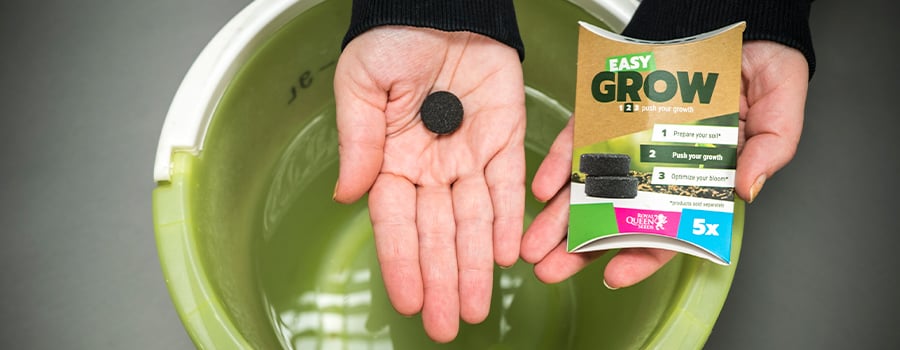
Nutrient Lockout: You're Prepared for This Common Problem
Nutrient lockout is one of the most frustrating cannabis plant health issues, mostly because it can happen when you’ve done everything else right. Soil pH might seem like a minor variable to manage, but it can truly make or break a growing cycle.
However, you’re now equipped with both the knowledge and the skills to treat and prevent cannabis nutrient lockout. If you’re dealing with this problem right now, don’t feel disheartened. Your plants can make a full recovery if you restore optimal soil pH, apply foliar feeds, and carefully manage pH going forward.
For more foundational tips and guidance, download our grow guide and ensure your plants thrive every step of the way!
Free RQS
Grow Guide!

- Certified Crop Advisor study resources (Northeast region) https://nrcca.cals.cornell.edu
 Grow Guide Topic Finder
Grow Guide Topic Finder
- Growing weed step by step
- Cannabis growing basics
- Choosing your seeds
- How to germinate seeds
- The cannabis vegetative stage
- The cannabis flowering stage
- Harvesting cannabis
- Trimming, drying, and curing
- Choosing pots and soil
-
Growing indoors
- A Complete Overview Of Growing Cannabis Indoors
- Cannabis Cultivation Tips: How To Set Up Indoor Grow Lights
- How Many Cannabis Plants Can You Grow Per Square Metre?
- Indoor Cannabis Growing: Relative Humidity and Temperatures
- Hydroponics Cannabis Growing Guide (with diagrams)
- Cannabis Micro Growing: Growing Great Weed in Tiny Spaces
- Growing outdoors
- How to grow autoflowering cannabis
- Cannabis nutrients and pH
- Cannabis troubleshooting: Nutrients
-
Cannabis troubleshooting: Growing
- Cannabis Seed Germination — Troubleshooting Guide
- How to Deal With Pythium (Root Rot) in Cannabis Plants
- Slow Cannabis Plant Growth And What You Can Do About It
- How to Prevent and Fix Stretching in Cannabis Seedlings
- Watering Your Cannabis: How to Fix Overwatering and Underwatering
- Understanding Male, Female, And Hermaphrodite Cannabis
- Identifying and Treating Common Cannabis Ailments
- How To Revive a Sick Cannabis Plant
- How to Avoid Mouldy Weed During Drying and Curing
- How to Prevent and Treat Dry and Crispy Cannabis Leaves
- What Cannabis Leaves Can Tell You
- Causes and Solutions for Yellow Cannabis Leaves
-
Cannabis Strains Grow Report
- HulkBerry Automatic Grow Report
- Blue Cheese Auto Grow Report
- Purple Punch Automatic Grow Report
- Triple G Automatic Grow Report
- Do-Si-Dos Automatic Grow Report
- Green Gelato Automatic Grow Report
- Haze Berry Automatic Grow Report
- Purple Queen Automatic Grow Report
- Cookies Gelato Automatic Grow Report
- Sherbet Queen Automatic Grow Report
- Sweet Skunk Automatic Grow Report
- Medusa F1 Grow Report
- Cannabis plant training
-
Weed growing tips
- The Cannabis Plant Anatomy
- How to preserve seeds
- How Much Sunlight Do Outdoor Cannabis Plants Need To Grow?
- How to Control and Prevent Stretching in Cannabis Plants
- My Cannabis Plants Are Growing Too Tall: What Should I Do?
- Should You Worry About Purple Or Red Cannabis Stems?
- What To Do When Your Indoor Cannabis Won’t Flower
- How To Protect Your Cannabis Plants From Heat Stress
- How To Tell If Your Female Cannabis Plant Has Been Pollinated
- Growing Medical Marijuana
- Bud Washing: How to Clean Your Weed
- Understanding Cannabis Yield per Plant





























